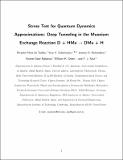Stress Test for Quantum Dynamics Approximations: Deep Tunneling in the Muonium Exchange Reaction D + HMu → DMu + H
Author(s)
Suleimanov, Yury V.; Richardson, Jeremy O.; Green, William H.; Aoiz, F. J.; Perez de Tudela, Ricardo; Saez Rabanos, Vicente; ... Show more Show less
Download3.pdf (257.0Kb)
PUBLISHER_POLICY
Publisher Policy
Article is made available in accordance with the publisher's policy and may be subject to US copyright law. Please refer to the publisher's site for terms of use.
Terms of use
Metadata
Show full item recordAbstract
Quantum effects play a crucial role in chemical reactions involving light atoms at low temperatures, especially when a light particle is exchanged between two heavier partners. Different theoretical methodologies have been developed in the last decades attempting to describe zero-point energy and tunneling effects without abandoning a classical or semiclassical framework. In this work, we have chosen the D + HMu → DMu + H reaction as a stress test system for three well-established methods: two representative versions of transition state theory (TST), canonical variational theory and semiclassical instanton, and ring polymer molecular dynamics (RPMD). These calculations will be compared with accurate quantum mechanical results. Despite its apparent simplicity, the exchange of the extremely light muonium atom (0.114 u) becomes a most challenging reaction for conventional methods. The main result of this work is that RPMD provides an overall better performance than TST-based methods for such a demanding reaction. RPMD might well turn out to be a useful tool beyond TST applicability.
Date issued
2014-11Department
Massachusetts Institute of Technology. Department of Chemical EngineeringJournal
The Journal of Physical Chemistry Letters
Publisher
American Chemical Society (ACS)
Citation
Pérez de Tudela, Ricardo, Yury V. Suleimanov, Jeremy O. Richardson, Vicente Sáez Rábanos, William H. Green, and F. J. Aoiz. “Stress Test for Quantum Dynamics Approximations: Deep Tunneling in the Muonium Exchange Reaction D + HMu → DMu + H.” The Journal of Physical Chemistry Letters 5, no. 23 (December 4, 2014): 4219–4224.
Version: Author's final manuscript
ISSN
1948-7185